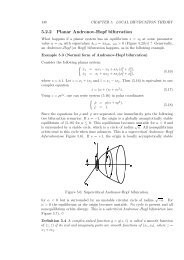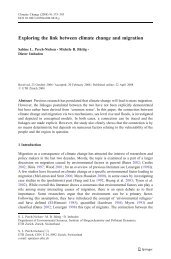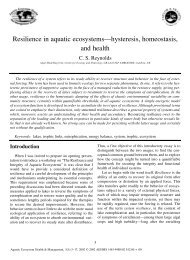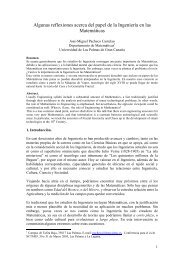Zwischen Naturschutz und Theoretischer Ökologie: Modelle zur ...
Zwischen Naturschutz und Theoretischer Ökologie: Modelle zur ...
Zwischen Naturschutz und Theoretischer Ökologie: Modelle zur ...
Sie wollen auch ein ePaper? Erhöhen Sie die Reichweite Ihrer Titel.
YUMPU macht aus Druck-PDFs automatisch weboptimierte ePaper, die Google liebt.
200 7 Literaturverzeichnis<br />
Teppema, J. (1998): Habitateignungsmodelle für ausgewählte Laufkäferarten des Drömlings - Feldexperimente<br />
<strong>und</strong> statistische <strong>Modelle</strong>. - Diplomarbeit (unveröff.); 75 S.; TU Braunschweig.<br />
ter Braak, C. J. F., Hanski, I. & Verboom, J. (1998): The incidence function approach to modeling of<br />
metapopulation dynamics. - In: Bascompte, J. & Solé, R. V. (eds.): Modeling spatiotemporal<br />
dynamics in ecology. - Berlin: Springer; 163-188.<br />
Thomas, J. A. (1993): Holocene climate changes and warm man-made refugia may explain why a sixth<br />
of british butterflies possess unnatural early-successional habitats. - Ecography 16: 278-284.<br />
Thomas, J. A. (1995): Why small cold-blooded insects pose different conservation problems to birds<br />
in modern landscapes. - Ibis 137: 112-119.<br />
Thomas, J. A. & Bovee, K. D. (1993): Application and testing of a procedure to evaluate transferability<br />
of habitat suitability criteria. - Regul. Riv.: Research & Management 8: 285-294.<br />
Thomas, J. A. & Morris, M. G. (1994): Patterns, mechanisms and rates of extinction among invertebrates<br />
in the United Kingdom. - Phil. Trans. R. Soc. Lond. B 344: 47-53.<br />
Thomas, C. D., Thomas, J. A. & Warren, M. S. (1992): Distributions of occupied and vacant butterfly<br />
habitat in fragmented landscapes. - Oecologia 92: 563-567.<br />
Thomas, J. A., Moss, D. & Pollard, E. (1994): Increased fluctuations of butterfly populations towards<br />
the northern edges of species' ranges. - Ecography 17: 215-220.<br />
Thomas, P. (1980): Wie reagieren Heuschrecken auf die Mahd? - Naturk<strong>und</strong>liche Beiträge des DJN 5:<br />
34-39.<br />
Thompson, D. J. (1990): The effects of survival and weather on lifetime egg production in a model<br />
damselfly. - Ecol. Entomol. 15: 455-462.<br />
Tilman, D., May, R. M., Lehman, C. L. & Nowak, M. A. (1994): Habitat destruction and the extinction<br />
debt. - Nature 371: 65-66.<br />
Tilman, D., Lehman, C. L. & Kareiva, P. (1997): Population dynamics in spatial habitats. - In: Tilman,<br />
D. & Kareiva, P. (eds.): Spatial ecology - the role of space in population dynamics and interspecific<br />
interactions. - Princeton, New Jersey: Princeton University Press; 3-20.<br />
Travis, J. M. J. & Dytham, C. (1998): The evolution of dispersal in a metapopulation: A spatially explicit,<br />
individual-based model. - Proc. R. Soc. Lond. B 265: 17-23.<br />
Trexler, J. C. & Travis, J. (1993): Nontraditional regression analyses. - Ecology 74: 1629-1637.<br />
Tuljapurkar, S. D. (1982): Population dynamics in variable environments. 2. Correlated environments,<br />
sensitivity analysis and dynamics. - Theor. Popul. Biol. 21: 114-140.<br />
Tuljapurkar, S. (1990): Population dynamics in variable environments. 154 S.; New York, Berlin,<br />
Heidelberg: Springer-Verlag.<br />
Tuljapurkar, S. (1996): Stochastic matrix models. - In: Tuljapurkar, S. & Caswell, H. (eds.): Structuredpopulation<br />
models in marine, terrestrial, and freshwater systems. - New York, Bonn, Melbourne:<br />
Chapman & Hall; 59-87.<br />
Tuljapurkar, S. D. & Orzack, S. H. (1980): Population dynamics in variable environments. 1. Long run<br />
growth rates and extinction. - Theor. Popul. Biol. 18: 314-342.<br />
Turchin, P., Reeve, J. D., Cronin, J. T. & Wilkens, R. T. (1998): Spatial pattern formation in ecological<br />
systems: Bridging theoretical and empirical approaches. - In: Bascompte, J. & Solé, R. V. (eds.):<br />
Modeling spatiotemporal dynamics in ecology. - Berlin: Springer; 199-214.<br />
Turner, M. G. (1989): Landscape ecology: The effect of pattern on process. - Ann. Rev. Ecol. Syst. 20:<br />
171-197.<br />
Turner, S. J., O'Neill, R. V., Conley, W., Conley, M. R. & Humphries, H. C. (1991): Pattern and scale:<br />
Statistics for landscape ecology. - In: Turner, M. G. & Gardner, R. H. (eds.): Quantitative methods<br />
in landscape ecology - the analysis and interpretation of landscape heterogeneity. - New York:<br />
Springer-Verlag; 17-50.<br />
Turner, T. F., Trexler, J. C., Miller, G. L. & Tayer, K. E. (1994): Temporal and spatial dynamics of<br />
larval and juvenile fish ab<strong>und</strong>ance in a temperate floodplain river. - Copeia 1: 174-183.<br />
Turner, M. G., Arthaud, G. J., Engstrom, R. T., Hejl, S. J., Liu, J., Loeb, S. & McKelvey, K. (1995):<br />
Usefulness of spatially explicit population models in land management. - Ecol. Appl. 5: 12-16.<br />
Tyler, J. A. & Rose, K. A. (1997): Effects of individual habitat selection in a heterogeneous environment<br />
on fish cohort survivorship: A modelling analysis. - J. Anim. Ecol. 66: 122-136.<br />
U.S. Fish & Wildlife Service (1980): Habitat evaluation procedures (HEP).- Washington DC.: USDI<br />
Fish and Wildlife Services, Division of Ecological Services.






